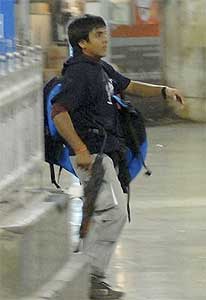
Kasab was to die as ‘Hindu terrorist’: ex-Mumbai police chief
Ajmal Amir Kasab, who was convicted for the 26/11 Mumbai terror attacks, might have died as a Bengaluru resident named Samir Dinesh Chaudhari, with a 'red thread tied around his wrist' if terror group Lashkar-e-Taiba succeeded in their plan, former Mumbai police commissioner Rakesh Maria said.

Ajmal Amir Kasab, who was convicted for the 26/11 Mumbai terror attacks, might have died as a Bengaluru resident named Samir Dinesh Chaudhari, with a ‘red thread tied around his wrist’ if terror group Lashkar-e-Taiba succeeded in their plan, former Mumbai police commissioner Rakesh Maria said.
Maria, in his book titled ‘Let Me Say It Now,’ claimed that the LeT had planned to make the attack appear as a case of ‘Hindu terrorism.’
“The headlines on newspapers would’ve been screaming about how Hindu terrorists had attacked Mumbai. But it had worked that way and here he was, Ajmal Amir Kasab of Faridkot, Pakistan,” News 18 quoted Maria as saying.

A picture of Kasab taken at the Mumbai airport hints at the plan by LeT for Hindu terrorism. Kasab is seen holding an AK-47 rifle and wearing a sacred red thread on his wrist.
Hindus tie the red thread, which is referred to as ‘kautaka’ or ‘mauli’ or ‘kalava’, on the right hand for males and left hand for females to invoke the blessings of a deity. It is a popular belief that the red thread protects a person from all kinds of dangers.
Sources reported earlier that the other attackers had carried fake IDs from Arunodhaya College in Hyderabad. Maria claimed that a similar ID was kept ready for Kasab.
However, Kasab was caught alive by the police, which foiled the original plans of the LeT. Had Kasab been gunned down like the other attackers during the encounter with the police, the latter might not have established the terror link with Pakistan.
‘Kasab thought Muslims were not allowed to perform namaaz or enter mosques’
Maria said, “Kasab truly thought Muslims were not allowed to perform namaaz in India, and that all the mosques were locked up by government authorities. He believed the azaan (prayers) he heard five times a day from the crime branch prison cell was just a figment of his imagination. When we understood this, I told Mahale (investigating officer Ramesh Mahale) to take him to the mosque near a cinema theatre.”
Maria said Kasab had been ‘bewildered’ when he witnessed a namaaz.
The former police commissioner said keeping Kasab alive was his first priority, since they needed the ‘only living evidence of that heinous crime.’ Maria claimed that, however, other police officers didn’t take to him as kindly since they were furious with him over the attacks.
Related news | Efficacy of Pak’s decision to send Hafiz to jail remains to be seen: Govt sources
Maria also said he interrogated Kasab every day to understand how terror outfits operated. “Our daily interaction forged a kind of bond between Kasab and me, and soon he began addressing me respectfully as ‘Janab’ (sir),” Maria revealed.
The book mentioned that after three weeks of training by the terror outfit for the attack, Kasab was given ₹1,25,000 and a week-long holiday to visit his family. Maria also claimed in the book that Kasab gave the money for his sister’s wedding.
According to Maria, the terror attack was originally planned for September 27, 2008, which was also the 27th day of roza. The 27th day of roza or Ramzan was considered the holiest day in the Islamic calendar year.


